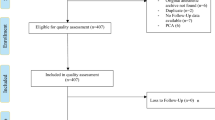Abstract
The aim of this study was to compare the efficacy of four analgesia techniques on postoperative pain after per-trochanteric femur fracture. A retrospective cohort study was conducted on 131 consecutive patients older than 75 years enrolled in an 18-month period and who underwent per-trochanteric fracture repair under spinal analgesia. Patients received postoperative analgesia from: G1 (n = 36), intravenous analgesia on demand only; G2 (n = 28) administration of acetaminophen at fixed hours; G3 (n = 50) continuous morphine infusion; G4 (n = 17), preoperative echo-graphic guided femoral nerve block. Continuous opioid infusion failed to prevent the onset of pain at the end of the effects of subarachnoid anesthesia (rescue dose of analgesic in 48 % of patients in G3 vs. 22 % in G2 in the first day; p < 0.05). The greater effectiveness was achieved by preventing the onset of pain with drugs administered at time intervals (rescue dose of analgesic in 48 % of patients in G3, 58 % in G1 and 48 % in G4 vs. 22 % in G2 in the first day and rescue dose of analgesic in 32 % of patients in G3, 67 % in G1 and 76 % in G4 vs. 18 % in G2 in the second day; p < 0.05). Our study does not confirm the effectiveness of a single shot femoral nerve block on postoperative pain in per-trochanteric femur fracture (PAIN VAS score > 3 at t1 in 23 % of patients in G1 and 19 % in G4 vs. 10 % in G2 and G3; p < 0.05).



Similar content being viewed by others
References
Apfelbaum JL, Chen C, Mehta SS, Gan TJ (2003) Postoperative pain experience: results from a national survey suggest postoperative pain continues to be undermanaged. Anesth Analg 97:534–540
Aubrun F (2005) Management of postoperative analgesia in elderly patients. Reg Anesth Pain Med 30:363–379
White SM, Rashid N, Chakladar A (2009) An analysis of renal dysfunction in 1,511 patients with fractured neck of femur: the implication for perioperative analgesia. Anaesthesia 64:1061–1065
Halaszynski TM (2009) Pain management in the elderly and cognitively impaired patient: the role of regional anesthesia and analgesia. Curr Opin Anaesthesiol 22:594–599
Kearn RJ, Moss L, Kinsella J (2013) A comparison of clinical practice guidelines for proximal femoral fracture. Anaesthesia 68:159–166
Yeap LY, Butterworth JF (2011) Analgesic techniques after total hip arthroplasty. Anesth Analg 113:687–688
Ilfeld BM (2011) Continuous peripheral nerve blocks: a review of the published evidence. Anesth Analg 113:904–925
Genth B, Von Düring M, Von Engelhardt LV, Ludwig J, Teske W, Von Schulze-Pellengahr C (2012) Analysis of the sensory innervations of the greater trochanter for improving the treatment of greater trochanteric pain syndrome. Clin Anat 25:1080–1086
Brown JG (1989) Systemic opioid analgesia for postoperative pain management. Anesth Clin North Am 7:51–57
Kehlet H, Dahl JB (1993) The value of “multimodal” or “balanced analgesia” in postoperative pain treatment. Anesth Analg 77:1048–1056
Parker RK, Holtmann B, Smith J, White PF (1994) Use of ketorolac after lower abdominal surgery. Anesthesiology 80:6–12
Kenny GNC (1992) Potential renal, haematological and allergic adverse effects associated with non steroidal anti-inflammatory drugs. Drugs 44:31–37
Lachiewicz PF (2013) The role of intravenous acetaminophen in multimodal pain protocols for perioperative orthopedic patients. Orthopedics 36:15–19
Ades A, Compère V, Abriou C, Baert O, Fourdrinier V, Dureuil B (2009) Acute respiratory distress subordinate to a morphine overdose during a frail elderly patient controlled analgesia. Ann Fr Anesth Reanim 28:384–387
Shapiro A, Zohar E, Zaslansky R, Hoppenstein D, Shabat S, Fredman B (2005) The frequency and timing of respiratory depression in 1,524 postoperative patients treated with systemic or neuraxial morphine. J Clin Anesth 17:537–542
Bernucci F, Carli F (2012) Functional outcome after major orthopedic surgery: the role of regional anesthesia redefined. Curr Opin Anaesthesiol 25:621–628
Woodhouse A, Mather LE (1997) The influence of age upon opioid analgesic use in the patient-controlled analgesia (PCA) environment. Anaesthesia 52:949–955
Jørgensen BC, Schmidt JF, Risbo A, Pedersen J, Kolby P (1985) Regular interval preventive pain relief compared with on demand treatment after hysterectomy. Pain 21:137–142
Conflict of interest
There is no actual or potential conflict of interest.
Author information
Authors and Affiliations
Corresponding author
Rights and permissions
About this article
Cite this article
Di Filippo, A., Magherini, M., Ruggiano, P. et al. Postoperative analgesia in patients older than 75 years undergoing intervention for per-trochanteric hip fracture: a single centre retrospective cohort study. Aging Clin Exp Res 27, 281–285 (2015). https://doi.org/10.1007/s40520-014-0272-5
Received:
Accepted:
Published:
Issue Date:
DOI: https://doi.org/10.1007/s40520-014-0272-5



